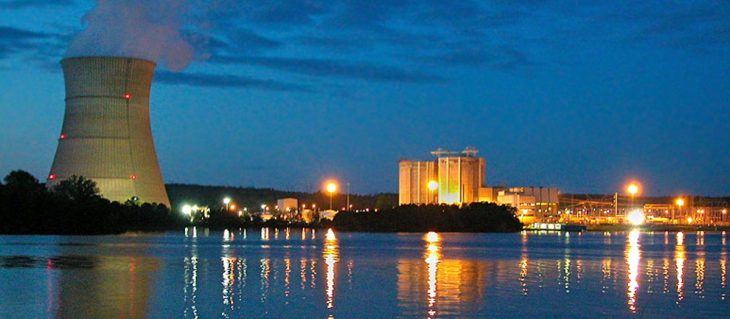Power plant generation to decline 2% this summer
by May 20, 2019 12:22 pm 304 views

Entergy's Arkansas Nuclear One power plant in Russellville, Ark. (photo from Entergy)
The amount of electricity U.S. power plants will generate in the summer months of June through August is expected to fall 2% to 1,168 million megawatt-hours, from the same period in 2018, according to the U.S. Energy Information Administration (EIA). Natural gas will provide 40% of total U.S. generation this summer, up from 39% in summer 2018. Coal will provide 25% of the generation, down from 28% last summer.
The amount of electricity U.S. coal-fired plants will generate is projected to fall 13% to 289 million megawatt-hours of electricity this summer, from the same period in 2018, according to the EIA. Coal plants will provide 45% of the total generation for the Midwest region this summer, down from 49% last summer. Coal will provide 23% of total generation in the South, down from 26% in summer 2018.
The amount of electricity natural gas-fired plants will generate is expected to rise by 2.5% to 472 million megawatt-hours this summer, from last summer. Natural gas is expected to account for about half of the electricity generation mix in the South and Northeast regions.
The amount of electricity nuclear power plants will generate is expected to be flat from last summer. The plants should provide 18% of total U.S. electricity generation this summer. Nuclear plants are expected to generate 31% of electricity in the Northeast this summer, down from 33% last summer, after the retirements of the Oyster Creek plant in New Jersey and the Pilgrim plant in Massachusetts.
The amount of electricity non-hydroelectric renewable sources such as wind, biomass, geothermal and utility-scale solar will generate is expected to be flat at 9% this summer. Hydroelectricity will provide 7% of total U.S. generation, up from 6% in summer 2018. With regard to non-hydroelectric renewables sources, wind generation is expected to produce the largest share at 6%. For the year, wind power is expected to produce 8% of total U.S. generation, and if realized, it would be the first time hydroelectricity didn’t provide the most generation of any other renewable resource.
